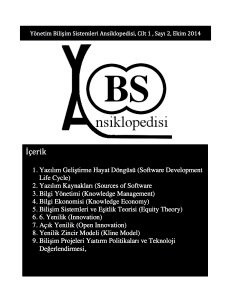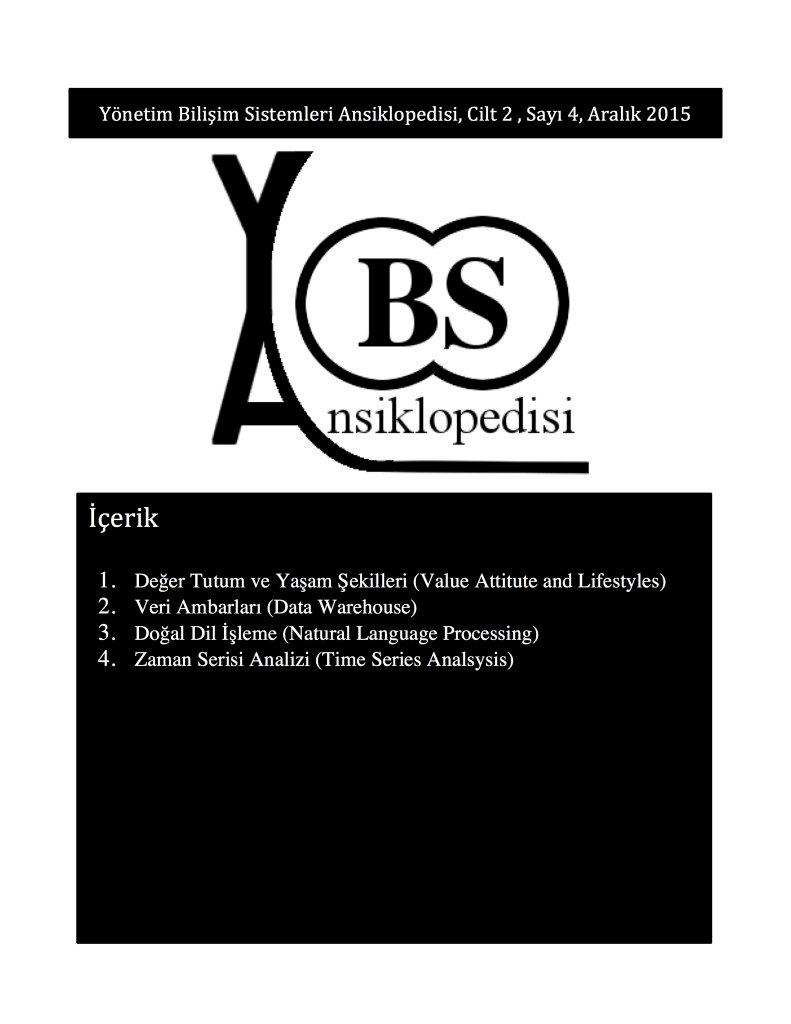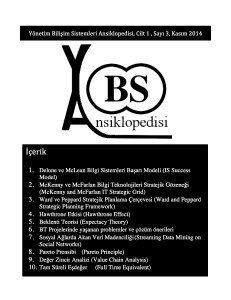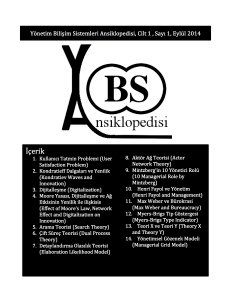
Sayının tamamına erişmek için tıklayın
İçindekiler
- Yazılım Geliştirme Hayat Döngüsü (Software Development Life Cycle), Sadi Evren SEKER, YBS Ansiklopedi, 1:2, 2-6
- Yazılım Kaynakları (Sources of Software), Sadi Evren SEKER, YBS Ansiklopedi, 1:2, 5-8
- Bilgi Yönetimi (Knowledge Management), Sadi Evren SEKER, YBS Ansiklopedi, 1:2, 8-14
- Bilgi Ekonomisi (Knowledge Economy), Sadi Evren SEKER, YBS Ansiklopedi, 1:2, 14-17
- Bilişim Sistemleri ve Eşitlik Teorisi (Equity Theory), Sadi Evren SEKER, YBS Ansiklopedi, 1:2, 17 – 20
- Yenilik (Innovation), Sadi Evren SEKER, YBS Ansiklopedi, 1:2, 20 – 24
- Açık Yenilik (Open Innovation), Sadi Evren SEKER, YBS Ansiklopedi, 1:2, 24- 27
- Yenilik Zincir Modeli (Kline Model), Sadi Evren SEKER, YBS Ansiklopedi, 1:2, 27-29
- Bilişim Projeleri Yatırm Politikaları ve Teknoloji Değerlendirmesi, Sadi Evren SEKER, YBS Ansiklopedi, 1:2, 29-33
Eski Formattaki makaleler için:
- Yazılım Geliştirme Hayat Döngüsü (Software Development Life Cycle), Sadi Evren SEKER, YBS Ansiklopedi, 1:2, 2-6
- Yazılım Kaynakları (Sources of Software), Sadi Evren SEKER, YBS Ansiklopedi, 1:2, 5-8
- Bilgi Yönetimi (Knowledge Management), Sadi Evren SEKER, YBS Ansiklopedi, 1:2, 8-14
- Bilgi Ekonomisi (Knowledge Economy), Sadi Evren SEKER, YBS Ansiklopedi, 1:2, 14-17
- Bilişim Sistemleri ve Eşitlik Teorisi (Equity Theory), Sadi Evren SEKER, YBS Ansiklopedi, 1:2, 17 – 20
- Yenilik (Innovation), Sadi Evren SEKER, YBS Ansiklopedi, 1:2, 20 – 24
- Açık Yenilik (Open Innovation), Sadi Evren SEKER, YBS Ansiklopedi, 1:2, 24- 27
- Yenilik Zincir Modeli (Kline Model), Sadi Evren SEKER, YBS Ansiklopedi, 1:2, 27-29
- Bilişim Projeleri Yatırm Politikaları ve Teknoloji Değerlendirmesi, Sadi Evren SEKER, YBS Ansiklopedi, 1:2, 29-33
Kaynaklar
- Au, N.; Ngai, E. W. T.; and Cheng, T. C. E.. 2008. “Extending the Understanding of End User Information Systems Satisfaction Formation: An Equitable Needs Fulfillment Model Approach,” MIS Quarterly, (32: 1)
- Benbasat, Izak; Zmud, Robert (1999). “Empirical research in information systems: The practice of relevance”. MIS Quarterly 23 (1): 3–16. DOI:10.2307/249403.
- Bontis, Nick; Choo, Chun Wei (2002). The Strategic Management of Intellectual Capital and Organizational Knowledge. New York: Oxford University Press. ISBN:0-19-513866-X.
- Brown L, Erwee R, Poh L. 2002. Knowledge integrator nodes in teams or networks in multinational enter- prises. IMP Conference. Perth.
- Caraça, João, Bengt-Åke Lundvall, and Sandro Mendonça (2009). “The changing role of science in the innovation process: From Queen to Cinderella?” Technological Forecasting & Social Change 76, 861–867.
- Davenport T, Prusak L. 1998. Working knowledge – How 74 organizations manage what they know. Harvard Business 75 School Press: Boston.
- Frand, Jason; Hixon, Carol (1999), “Personal Knowledge Management : Who, What, Why, When, Where, How?”, Working paper, UCLA Anderson School of Management
- Geisler E. 2007, A typology of knowledge management: strategic groups and role behavior in organizations, Journal of Knowledge Management, 11(1), 84-96
- Glass, Richard S.; Wood, Wallace A., Situational determinants of software piracy: An equity theory perspective Journal of Business Ethics, November 1996, Volume 15, Issue 11, pp 1189-1198
- Goodhue, D.L. (1998), “Development and Measurement Validity of a Task-Technology Fit Instrument for User Evaluations of Information Systems”, Decision Sciences (19:1) pp. 105-138.
- Guerrero, Andersen, and Afifi. (2007). Close Encounters: Communication in Relationships, 2nd edition. Sage Publications, Inc.
- Gupta, Jatinder; Sharma, Sushil (2004). Creating Knowledge Based Organizations. Boston: Idea Group Publishing. ISBN:1-59140-163-1.
- Hansen, M. T. Nohira, N. and Tierney T. (1999 What’s Your Strategy for Managing Knowledge?, Harward Business Review, Vol. 77, No. 2, Pages 106-116, 1999.
- Hess, Traci and Hightower, Ross,(2002) “Using Equity Theory to Understand User Satisfaction with ERP Systems: Extending and Advancing the Equity- Implementation Model” (2002). ICIS 2002 Proceedings. Paper 72.
- Joshi, K. (1991) “A Model of Usersí Perspective on Change: The Case of Information Systems Implementation”, MIS Quarterly (15:2), 1991, pp. 229- 242.
- Kendall E. K. ve Kendall J. E. (2013), System Analysis and Design, 9th ed. Prentice Hall, 2013, ISBN: 0133023443
- Kline (1985). Research, Invention, Innovation and Production: Models and Reality, Report INN-1, March 1985, Mechanical Engineering Department, Stanford University.
- Kline, S.J. & N. Rosenberg (1986). “An overview of innovation.” In R. Landau & N. Rosenberg (eds.), The Positive Sum Strategy: Harnessing Technology for Economic Growth. Washington, D.C.: National Academy Press, pp. 275–305.
- Laudon K ve Laudon J, (2011) Management Information Systems, 12. Baskı, Prentice Hall, 2011, ISBN: 0132142856
- Nonaka, Ikujiro (1991) “The knowledge creating company”. Harvard Business Review69 (6): 96–104.
- Nonaka I, Takeushi H. 1995. The Knowledge-Creating Com- pany: How Japanese Companies Create the Dynamics of Innovation. Oxford University Press: New York.
- Lehner, Franz; Nicolas Haas (2010). “Knowledge Management Success Factors”. Electronic Journal of Knowledge Management 8 (1): 81
- McKenna, R. 1985. The Regis Touch: New Marketing Strategies for Uncertain Times, Boston: Addison-Wesley.
- Moore C, Rugullies E. 2005. The Information Workplace Will Redefine The World Of Work At Last. Forrester Research.
- Reinhardt, W.; Schmidt, B.; Sloep, P.; Drachsler, H. (2011). “Knowledge Worker Roles and Actions – Results of Two Empirical Studies”. Knowledge and Process Management 18 (3): 150–174
- Robert G. Fichman, Brian L. Dos Santos, Zhiqiang (Eric) Zheng, 2014, Digital Innovation As A Fundamental And Powerful Concept In The Information Systems Curriculum, MIS Quarterly Vol. 38 No. 2, pp. 329-353/June 2014
- Schutte, Corne; Marais, Stephan (2010). The Development of Open Innovation Models to Assist the Innovation Process. University of Stellenbosch, South Africa.
- Seker, S.E. and Diri, B. 2010, TimeML and Turkish Temporal Logic, International Conference on Artificial Intelligence, ICAI’10, v. 10, pp. 881-887
- Sadi Evren SEKER, Khaled Al-NAAMI “Sentimental Analysis on Turkish Blogs via Ensemble Classifier“, Proceedings Of The 2013 International Conference On Data Mining, ISBN:1-60132-239-9, DMIN, pp. 10-16, 2013
- Seker, S. E. , Unal, Y. , Erdem Z. , Kocer, H. E. (2014), “Ensembled Correlation between Liver Analysis Outputs”, International Journal of Biology and Biomedical Engineering, ISSN: 1998-4510, Volume 8, pp. 1-5, 2014
- Seker, S. E. , Mert, C. (2013), “A Novel Feature Hashing For Text Mining”, International Black Sea University Journal of Technical Science & Technologies,2013, Issn : 2298-0032, vol.2, pp.37-40
- Seker, S. E. , Altun, O. , Ayan, U, Mert, C. (2014), “A Novel String Distance Function based on Most Frequent K Characters”, International Journal of Machine Learning and Computation (IJMLC),2014, Issn : 2010-3700, vol.4, is.2, pp.177-183
- Seker, S. E. 2014, Dijitalleşme, YBS Ansiklopedi, V. 1, Is. 1, pp. 6-9.
- Seker S. E. 2014 Maslow’un İhtiyaçlar Piramiti ve Yönetim Bilişim Sistemleri, YBS Ansiklopedi, 1:1, 34 – 37
- Seker, S. E. 2014 Bilgi Ekonomisi, YBS Ansiklopedi, v. 1, is. 2, pp. 14- 17
- Seker, S. E. 2014 Bilgisayar Kullanıcısı Tatmin Problemi (Computer User Satisfaction Problem), Ansiklopedi, 1:1, 2-4
- Snyder-Halpern R, Corcoran-Perry S, Narayan S. 2001. 102 Developing clinical practice environments supporting 103 the knowledge work of nurses. Computers in Nursing 19(1): 17–23.
- Spector, P .E. (2008). Industrial and Organizational Behavior (5th ed.). Wiley: Hoboken, NJ.
- Teece, D. J. 1986. “Profiting from Technological Innovation: Implications for Integration, Collaboration, Licensing and Public Policy,” Research Policy (15:2), pp. 285-305.
- West, J.; Gallagher, S. (2006). “Challenges of open innovation: The paradox of firm investment in open-source software”. R and D Management 36 (3): 319.
- Wright, Kirby (2005). “Personal knowledge management: supporting individual knowledge worker performance”. Knowledge Management Research and Practice 3 (3): 156–165. DOI: 10.1057/palgrave.kmrp.8500061.
- Vassiliou, Marius, Stan Davis, and Jonathan Agre (2011). “Innovation Patterns in Some Successful C2 Technologies.” Proc. 16th International Command and Control Research and Technology Symposium
- Woodroof, J. and Kasper, G (1998), “A Conceptual Development of Process and Outcome User Satisfaction”, Information Resources Management Journal (11:2), pp. 37 – 43.
Google Scholar
Academia.edu
E-Prints
 Sayının tamamına erişmek için tıklayınız.
Sayının tamamına erişmek için tıklayınız.

